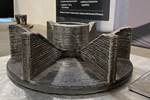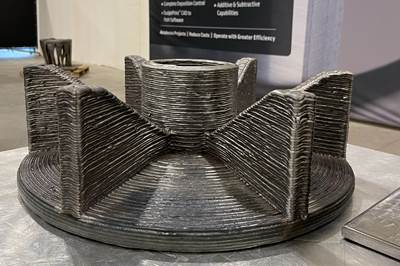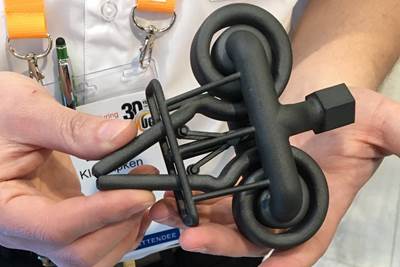For a cracked bearing housing on an industrial mixer, obtaining a replacement casting would have entailed considerable delay. Welding technology company Lincoln Electric uses the mixer, and others just like it, to make flux — a granulate used in welding. The company turned to its own Lincoln Electric Additive Solutions to use wire arc additive manufacturing (WAAM), which involves metal deposition using a robot, to produce the 500-pound carbon steel component. WAAM’s capabilities for reorienting the part during deposition allowed for 3D printing the form without support structures, and additive manufacturing made possible a design improvement that will carry through to other flux mixer bearing housings that soon will also be replaced via WAAM. Learn more about The Cool Parts Show’s biggest metal AM part yet in our 50th episode. | This episode of The Cool Parts Show brought to you by Carpenter Additive
The Cool Parts Show is a video series from Additive Manufacturing Media that explores the what, how and why of unusual 3D printed parts. Watch more here.
Have a cool part to share? Email us.
Related Resources
- AM Radio podcast episode with conversation about the 50th episode of The Cool Parts Show
- Also made by WAAM: this giant mixer blade for the same machine
- Lincoln Electric Additive Solutions
- More on wire arc additive manufacturing
- The link between robots and 3D printing
Transcript
Stephanie Hendrixson
A brand new solution for a century-old machine.
Peter Zelinski
Our first too-big-for-the-studio metal additive part on this episode of The Cool Parts Show. The Cool Parts Show is brought to you by Carpenter Additive. When it comes to managing metal powder, there is no one-size-fits-all approach.
Peter Zelinski
Stick around after the episode to learn more. I'm Pete.
Stephanie Hendrixson
I'm Stephanie.
Peter Zelinski
Welcome to The Cool Parts Show.
Stephanie Hendrixson
This is our show all about cool, unique, interesting 3D printed parts. And today we're on the road to show you a cool part that was so heavy, we couldn't get it into our studio.
Peter Zelinski
Right. This is our first too-big-to-travel 3D metal printed part. 3D printed in carbon steel. And this is a digitally manufactured replacement part for a piece of machinery that's going on 100 years old.
Stephanie Hendrixson
That's right. So we're going to talk about legacy replacement parts here. We're going to talk about digital inventory, all kinds of interesting things. But first, let's just talk about the setting. So we are here at Lincoln Electric Additive Solutions. Lincoln Electric, the parent company, is very well known for providing welding equipment, welding materials.
Peter Zelinski
And Lincoln Electric Additive Solutions is applying welding in a new way. Using it as a means of 3D printing.
Stephanie Hendrixson
Wire arc additive manufacturing: think robots printing with welding wire.
Peter Zelinski
And in this case, that was very helpful to a different part of Lincoln Electric, a manufacturing process related to welding. A substance used in welding is flux, a granulite particulate material. This is a replacement component for a machine used to make flux.
Peter Zelinski
Here is the 3D printed version. Here's the finished machine version. But this is a flux mixer bearing housing.
Stephanie Hendrixson
Right. So flux, if you know welding, you probably already know this. But if not, flux is this material that's used as a coating on stick electrodes. As you're welding, the material protects the weld. It can help it fuse and flow and provide other benefits as well.
Stephanie Hendrixson
So Lincoln Electric has seven of these giant machines that are used to mix flux. At any given time, six of them are being used in production and the seventh is being pulled out and repaired going through preventive maintenance.
Peter Zelinski
So old, old machines re-engineered, rebuilt all the time. And in the course of one of these rebuilds, they discovered that this vital component, the housing for a big bearing, was starting to crack and needed to be replaced.
Stephanie Hendrixson
All right. So let's bring in one of our experts. This is Brandon Juszczyk. He is the manager of the engineering facility team here at Lincoln Electric.
Brandon Juszczyk
During one of our repairs, we disassembled a mixer and noticed that one of the bearing housings had developed a crack. The bearing housing is one of these large steel castings that's original to the OEM design. And although at the moment it wasn't a catastrophic failure, we know that a crack of this type is going to require replacement
A repair on a component like this can be really difficult. We likely would have tried to contact the OEM and source a replacement. However, due to its age, it's likely that we would be making our own mold or paying the OEM to develop that mold again, to recast an 80-plus-year-old part. A challenge that's probably not normally thought of is once you invest in these molds, is then storing these molds, especially for components that you're not going to use all that often. We had a mold that it had been stored for ten plus years before I had to make another part. And at the time, to go use the mold, I then had to invest more money into repairing and refurbishing the mold just so I could use it again.
Peter Zelinski
So Brandon talked about how the challenge with getting this part remade is the need for a mold. Are we aware of any part making processes that don't need mold tooling?
Stephanie Hendrixson
I'm glad you asked. It turns out wire arc additive manufacturing is a great solution to getting large metal parts pretty quickly. So Brandon and his team were pretty lucky that when they discovered this problem, they have this whole other division within Lincoln Electric that's really good at applying wire arc additive manufacturing to get large parts like this.
Peter Zelinski
Can we learn more about wire arc additive manufacturing?
Stephanie Hendrixson
Sure. Wire arc additive manufacturing, or as we call it sometimes WAAM, is a type of metal 3D printing. Technically, it's a type of directed energy deposition, and it's similar to traditional welding, like you're using an arc as the mechanism to to melt and fuse the material.
But with traditional welding, you're usually thinking about like joining two or more parts together and with WAAM, it's more the case that you're building something up from scratch. So here at Lincoln Electric, the WAAM systems that they use are fed by welding wire.It's the same welding material that you could use in other situations, and the deposition heads are mounted on robotic arms. So that's how they get the motion into the system. Sometimes they also pair those robots with turntables or other motion devices to get even more flexibility.
Peter Zelinski
So, two things about that. So first of all, 3D printing in metal with a robot. So you think of 3D printing and you usually think of that happening inside a 3D printer. The robot makes this a great solution for really big parts because if you're using a 3D printer, it's a box and you need a machine bigger than the part that you're making. But in this case, here's a way to get a big part without needing a big machine around it. Essentially, within any area of space and volume that that robot can reach, you can build a part.
And then another aspect of this is that that robot has a lot of freedom of motion, a lot of ability to pivot, apply this material from different angles, different directions, combining that with the freedom to pivot and rotate the part, maybe with a pivoting turntable that the part is mounted on.
All of that means that these layers of deposition don't have to be parallel to one another. They can happen at different angles. That provides a lot of freedom for creating features of the component without support structures that have to be removed later, and that freedom proved instrumental in making this particular component.
So now let's bring in Brad Barnhart, an engineer with Lincoln Electric Additive Solutions.
Brad Barnhart
In the eyes of traditional AM it was definitely unusual and a little bit less so for WAAM, but we did need to print this component in multiple directions due to the part having significant portions of geometry having overhang. Right. So. And what I mean by different directions is we repositioned the printed part using one of our robotic manipulators, such that whenever we are welding on it, we don't have to fight gravity the entire time. We always want to be welding down, not from the side or underneath.
Those things are a little bit more complicated to do and to do accurately. So we can move the part as needed just to make the welding much easier. We do this mainly because we want to avoid creating support structures.
We don't want to print extra material when we don't need it, mainly because you need to machine it off. Or it might further increase weight. And unlike the powder bed side, where a lot of support structures are relatively thin in nature, this is fully dense. If you're printing, you know, an inch thick support structure, it's an inch to take off in material that's fully dense.
Stephanie Hendrixson
As Brad just described, WAAM and the way that it plays out at Lincoln Electric allows you to avoid those support structures. And that's a really big deal. Like we've seen that be a real challenge in other types of 3D printing. So, if you think about laser powder bed fusion, you might be designing some kind of crazy support under your part just to make sure it prints right. And that means you also have to figure out how to remove that crazy support structure later.
And so for a part like this being made from WAAM, you're saving the time of removing supports on the back end, as well as getting away from the lead time of needing casting tooling, as Brandon was describing earlier.
But let's talk about the design of these parts, because Lincoln Electric had an opportunity to not just create what already existed, but to sort of really think about what this component needed to do and make some alterations to the design.
Peter Zelinski
Lets focus in on that last part, because this is an 80-, 90-year-old machine and there is a lot of industrial work being done on machines that are like that, machines that have been in service for decades.
They need replacement parts. And it goes without saying, there's no CAD model in existence, But likely there's no print either. There's no drawing. So how did they get the dimensions? How did they get the geometry for this part?
Stephanie Hendrixson
So in this case, it all started with a 3D scan. So that's how they got a model of the part to begin with. But that doesn't mean that that was the design that they stuck with.
Brad Barnhart
When we 3D scan all of our parts, we are using a Creaform piece of equipment. We have the Metrascan, so it's a contactless structured light scanner. So we're able to reconstruct the surface of the thing that we are scanning.
And that's been real convenient because when you start going to large parts that may be still in the environment in which they're operating, they might be out of it, but it's a portable solution where we can go get a quick 3D scan.
And when I say quick, these parts that are on the order of feet can be scanned in a matter of minutes. We take that 3D scan, this surface model, and we use that as a basis for recreating a solid CAD model to print off.
Brandon Juszczyk
So one of the other advantages is once we started scanning the part and got it into the CAD environment is we get our engineering hands on it and we start making improvements. So the original casted design had a blind pocket, which required some difficult measuring machining to set the proper preload on that bearing.
Now we have the opportunity here, we were able to modify that design in a way that would give us access to this blind pocket. And we really think it's going to improve our ability to set the proper preload on the bearings, which will ultimately extend the life of machine.
Stephanie Hendrixson
So something I want to say here is that while this was a case where the part was cracking, it wasn't like a catastrophic failure. It wasn't an emergency situation. So, Lincoln did have time to sort of sit back and think about what this part does, what they'd like it to do, make those design improvements.
All that being said, they still achieved the production of this part on a timeline that's much faster than they could have gotten tooling made and got a casting and gone through the conventional route.
Peter Zelinski
This is a 500-pound part. They 3D printed it in about four days. The freedom to pivot it in different directions meant there were no support structures needed, so they avoided that challenge that's common in 3D printing. It needed some machining.
We can see the machined surfaces here. A nearby machine shop was able to do that pretty quickly. So all told, the lead time, the turnaround for this was very fast. This was a very efficient way to produce and obtain this part. It was such an efficient way to get these parts that for other mixers Lincoln Electric is not waiting for the bearing housing to fail.
Stephanie Hendrixson
That's right. Brandon told us that they want to test the 3D printed bearing housing for a little while, but assuming everything goes well, this is just going to be a regular part of the maintenance on the other mixers.
Peter Zelinski
I think we got this. Do you think we've got this?
Stephanie Hendrixson
I think so.
Peter Zelinski
All right, I'll start. This is a flux mixer bearing housing. This housing, the original was starting to crack. They discovered it was eventually going to fail. It needed to be replaced. The replacement was made not through casting like the original, but made through wire arc additive manufacturing.
Stephanie Hendrixson
The facility engineering team was able to take a 3D scan of the existing part. They use that as the basis to do some design improvements, make some tweaks, and then they were ready to 3D print it. So these parts are 3D printed from carbon steel using wire arc additive manufacturing.
They weigh about 500 pounds and it takes about four days to print one. After they're printed, they need some finished machining before they can go into use. And because of the results of this project, Lincoln Electric anticipates that they're going to be able to swap out this component on all of their flux mixers and proactively make this upgrade to their to their systems. So, this is an example of how 3D printing can be used as a replacement for casting. It's an example of how it can be used for legacy components. It's also a digital inventory example because Lincoln Electric has gone through this process of creating a digital design for these parts. The next time they need one, they can just print another. They don't have to worry about keeping these in inventory or storing, casting, tooling or any of that.
Peter Zelinski
Thank you, Lincoln Electric. Awesome Cool Part! Our first too-big-to-travel metal additive component. Thank you, Lincoln Electric Additive Solutions for hosting us at your facility.
Stephanie Hendrixson
If you like this episode, leave us a like leave us a comment and make sure to subscribe to our channel so you get notified about all of our new episodes. And if you have a cool part you'd like to see featured, even if it's too big to travel, let us know: CoolParts@AdditiveManufacturing.media. Thanks for watching.
Related Content
Video: AM for Repair of Large Shafts
Wind power shafts that might once have been scrapped are now returned to service. See the robotic directed energy deposition (DED) and shaft preheating system developed by Ikergune, Izadi and Talens.
Read MoreVideo: Construction 3D Printing with Robotics, Geopolymer
Alquist 3D is aiming to revolutionize construction and infrastructure with large-format robotic 3D printing using a carbon-neutral material.
Read MoreChuck Jaws Achieve 77% Weight Reduction Through 3D Printing
Alpha Precision Group (APG) has developed an innovative workholding design for faster spindle speeds through sinter-based additive manufacturing.
Read MoreCopper, New Metal Printing Processes, Upgrades Based on Software and More from Formnext 2023: AM Radio #46
Formnext 2023 showed that additive manufacturing may be maturing, but it is certainly not stagnant. In this episode, we dive into observations around technology enhancements, new processes and materials, robots, sustainability and more trends from the show.
Read MoreRead Next
The Way Ahead for Wire Arc Additive Manufacturing
Tooling today, production tomorrow. The capability will advance as value is increasingly seen in lead time savings and design opportunities. Parts that today are cast offer a particularly promising application for a process that is “welding, except not.”
Read More4 Ways Robots and 3D Printing Intersect
Four examples of how robotic automation and additive manufacturing both help and are helped by each other.
Read MoreProfilometry-Based Indentation Plastometry (PIP) as an Alternative to Standard Tensile Testing
UK-based Plastometrex offers a benchtop testing device utilizing PIP to quickly and easily analyze the yield strength, tensile strength and uniform elongation of samples and even printed parts. The solution is particularly useful for additive manufacturing.
Read More



















